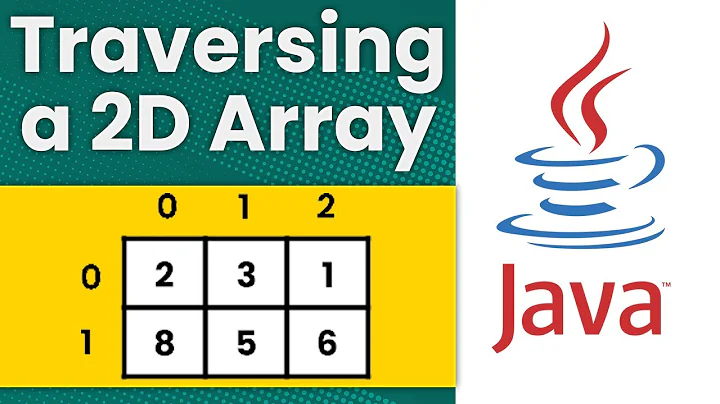How to Rotate a 2D Array of Integers
Solution 1
If they're a 2D array, you can implement rotation by copying with different array access orders.
i.e., for a clockwise rotation, try:
int [,] newArray = new int[4,4];
for (int i=3;i>=0;--i)
{
for (int j=0;j<4;++j)
{
newArray[j,3-i] = array[i,j];
}
}
Counter-clockwise is similar.
Solution 2
Don't rotate the pieces with code. Just store an array of the different piece orientations and cycle through them when the piece is rotated. There's no need to dynamically rotate them in a Tetris game.
As the problem domain is Tetris, you will find that a rotation algorithm causes undesirable effects, such as the long thin Tetronimo not alternating between two positions (as it does in the real thing).
Solution 3
In classic tetris there are very few permutations of objects. I would simply have a constant array for each "tetromino," at each of the 4 positions, and simple logic to choose the appropriate one based on input.
Why waste CPU cycles trying to rotate it?
Solution 4
If you want to rotate a 4 x 4 block, you just move the positions:
A B C A
C D D B
B D D C
A C B A
Each A moves to the next A, and the same for B, C and D.
/-----\
| |
| V
A B C A
/->C D>D B--\
| B D D C |
| A C B A |
| | ^ |
| | | |
\----/ \----/
Solution 5
int[,] source = { { 1,2,3 }, {4,5,6 }, { 7,8,9} };
int[,] result = new int[3,3];
var rows = source.GetLength(0);
var cols = source.GetLength(1);
for (var r=0; r<rows; r++)
{
for (var c = 0; c < cols; c++)
{
result[r, c] = source[rows - 1 - c, r];
}
}
Related videos on Youtube
Brock Woolf
I predominantly code in Objective-C (Cocoa Touch) and C# (.net) I write games and utility software and do iPhone and iPad development. More here: BrockWoolf.com.
Updated on February 07, 2020Comments
-
Brock Woolf over 4 years
I am programming a Tetris clone and in my game I store my tetromino blocks as 4x4 arrays of blocks. I now need to be able to rotate the integer positions in the arrays so that I get a rotated tetris block. I cannot simply rotate the texture because all my collision detection, etc has been designed to work with the 2D array. The game is written in C# using XNA.
How can i possibly rotate my 2D array of ints by 90 degrees clockwise/counter clockwise.
Here is how my 'L' block is stored as an example.
0 1 0 0 0 1 0 0 0 1 1 0 0 0 0 0Thanks for your help.
-
Reed Copsey about 15 yearsThe math is so simple in this case, it's probably just as fast to rotate it as it would be to do the permutation search based on the current block style + position.
-
Matt Howell about 15 yearsI'd also add that from a gameplay and design point-of-view, it might be better to have pre-set rotations. What do you do when you get the long 4x1 piece? If you rotate it twice, should it really be one full space over to the side (which it would be if you use pure math)?
-
Ryan Emerle about 15 yearsGood solution, but overkill given the problem domain.
-
 Ricket about 15 yearsCPU cycles are not an issue in this case. Do not try to overoptimize by thinking about "wasting CPU cycles". Whether you store 4 different permutations and select one, or loop through and rotate the array, either way will be so minimal a time span that it won't matter at all. Down vote.
Ricket about 15 yearsCPU cycles are not an issue in this case. Do not try to overoptimize by thinking about "wasting CPU cycles". Whether you store 4 different permutations and select one, or loop through and rotate the array, either way will be so minimal a time span that it won't matter at all. Down vote. -
 Ricket about 15 years-1; There is no advantage to storing 4 orientations of each piece rather than just rotating. You should be focused on answering his question, not discouraging him, unless he's making a critical mistake; which he certainly is not.
Ricket about 15 years-1; There is no advantage to storing 4 orientations of each piece rather than just rotating. You should be focused on answering his question, not discouraging him, unless he's making a critical mistake; which he certainly is not. -
Brock Woolf about 15 yearsI have a 2.4GHz Core 2 Duo processor, not to mention that a double for loop that checks an integer is doing a comparison of 8 bytes times 16. That's almost nothing at all for the CPU. Plus what if I one day wanted a 5x5 matrix? I'd have to recode it all.
-
 Ricket about 15 yearsI think your picture is a little off, not sure exactly what you're trying to clarify with it and the arrows seem to point b -> c and a -> c rather than supporting your instructions. fmsf, grow up.
Ricket about 15 yearsI think your picture is a little off, not sure exactly what you're trying to clarify with it and the arrows seem to point b -> c and a -> c rather than supporting your instructions. fmsf, grow up. -
 Ricket about 15 yearsI am voting this up, it should be marked as the solution. Not sure what you mean rde6173, unless you too are vouching for storing 4 orientation arrays.
Ricket about 15 yearsI am voting this up, it should be marked as the solution. Not sure what you mean rde6173, unless you too are vouching for storing 4 orientation arrays. -
Reed Copsey about 15 yearsThat's what he's suggesting. There are advantages to that, but this answers the question directly - I wasn't trying to suggest alternate designs.
-
Jon about 15 yearsRicket, easy on the tone there. I have updated my answer to indicate why rotation is a bad idea in this case.
-
Reed Copsey about 15 yearsNo problem :) Glad I can help.
-
Ian almost 15 yearsIt's not about the time it takes you to write as a developer, it's all about the time it takes to execute. Remember, compilers might be good at optimising loops, but they're even better when it comes to constants.
-
devilcrack about 14 yearsI agree with Jon, I've just been contemplating this problem myself. If you rotate the array, the blocks don't rotate the same way as they do in the original game. They appear to rotate around the centre.
-
Merlyn Morgan-Graham over 12 yearsThis is not overkill as it will save manual labor of producing those pre-transformed arrays, and will be extensible to non-tetraminos if further work is put into the game beyond basic tetris. (Will +1 tomorrow when my votes reset :)
-
 devsaw over 10 yearsIt's up to the programmer whether he wants to rotate the piece or store it as 4 orientation arrays.There's not that much labour in writing out 7 * 4 pieces.I would prefer rotating though.
devsaw over 10 yearsIt's up to the programmer whether he wants to rotate the piece or store it as 4 orientation arrays.There's not that much labour in writing out 7 * 4 pieces.I would prefer rotating though. -
StepUp about 7 yearsReed, please, be very kind, see my question stackoverflow.com/questions/42496192/…









